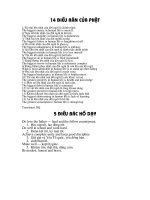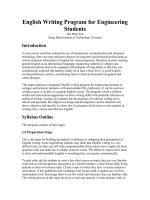Mineral processing for erasmus students
Bạn đang xem bản rút gọn của tài liệu. Xem và tải ngay bản đầy đủ của tài liệu tại đây (528.3 KB, 15 trang )
Metallurgy
•
Lecturer : Hong Vu, Ph.D., , tel.:5025,
room A50
•
Literature: Chemical Metallurgy (J.J. Moore)
•
Website: web.vscht.cz/vun/vun.htm
What is Metallurgy ?
The extraction process applies one or
more of three types of metallurgy :
pyrometallurgy, hydrometallurgy and
electrometallury
Most metals occur in nature in mineral form,
although a small number of metals (e.g., Cu, Ag, Au,
Hg, Pt) may occur in their metallic state.
Substances
Examples
Elements
Au, Ag, Cu, As, Sb, Bi
Sulfides
CuS, Cu2S, PbS, ZnS, NiS, Cu5FeS4,
CuFeS2, FeS, FeS2, MoS2
Oxides and hydroxides
Fe2O3, Fe3O4, FeTiO3, FeCr2O4, TiO2, MnO2,
SnO2, Al2O3, Al(OH)3, AlOOH, FeOOH
Halides
NaCl, KCl, CaF2, Na3AlF6, KMgCl3· 6 H2O,
Cu2Cl(OH)3
Carbonates, nitrates, and borates
MgCO3, CaCO3, FeCO3, MnCO3, ZnCO3,
CaMg(CO3)2, Cu2CO3(OH)2, NaNO3, Na2B4O7· 10 H2O
Sulfates, chromates, molybdates, and
BaSO4, PbSO4, CaSO4, CaSO4· 2 H2O, KFe3(SO4)2(OH)6
tungstenates
CaWO4, FeWO4
Phosphates, arsenates, and vanadates
(Ca, Ce, Nd)PO4, (Ce, La, Th)PO4
Silicates
ZrSiO4, ZnSiO4, SiO2, LiAlSi2O6
Metal ores are concentrations of above metal
compounds associated with other unwanted minerals
(gangue) such as silicates
Comminuation
grinding
(size
reduction):
crushing
and
Particle Selection
Separation according to Particle Size: The separation of particles according to
size is effected by the use of physical barriers and screens or by the differential
movement of solid particles through fluids: rake classifiers, sedimentation
classifiers, and hydrocyclones.
Separation according to Density: The sorting of particles as a function of their
density may be performed in unit operations and devices such as Humphreys
Spiral, shaking tables, jigging and tabling operations, dense-medium separation
Separation due to Surface Properties (Flotation): Air bubbles, which are blown
through a pulp, attach selectively to the valuable particles (e.g., various sulfides)
and float to a froth which is skimmed off and collected as concentrate. Thr flotation
process is carried out in cells, columns, and air-sparged hydrocyclones. Flotation
cells are arranged in banks which are interconnected so as to produce maximum
recovery.
Magnetic and Electrostatic Sorting: These techniques (wet or dry) utilize the
magnetic (e.g., with magnetite), electrical conductive, and induced electrostatic
properties of various minerals and materials to separate the valuable mineral or
material from the surrounding gangue.
Particle Selection
X-Ray Sorting. When certain materials (e.g., diamonds) are irradiated by X-rays they
become luminous and, hence, can be detected electronically and sorted from the
gangue material.
Solid – Liquid Separation. The recovery of solids from liquid media, either to clarify
solutions for hydrometallurgical treatment or to dewater pulps for pyrometallurgical
operations, can be performed in drum, leaf, and sand filters, thickeners, as well as
decanting and centrifuging processes.
Gas Cleaning. Gas cyclones, bag filters, and electrostatic precipitators are used to
clean gases or to recover valuable minerals from flue gases from pyrometallurgical
operations, before they are vented to the atmosphere.
Flotation
The flotation process relies primarily on the fact that hydrophilic particles
are wetted by water, whereas hydrophobic particles are wetted by oils and
air bubbles
Flotation Reagents
Collectors. These are used primarily to make solids hydrophobic and
promote adhesion to air bubbles or oil droplets. Common examples are
fatty acids, sulfonates, xanthates (dithiocarbonates), amines, and
dithiophosphates.
Frothers. Frothers promote the formation of a metastable froth phase
that facilitates the removal of particles carried by air bubbles to the top of
the flotation cell. Examples of frothers are pine oil, long-chain alcohols,
and polyoxypropylene
Auxiliary Reagents. These reagents include depressants, which are
used to prevent solids from becoming hydrophobic, and activators, which
promote the adsorption of reagents onto selected solids.
Flotation Cells
Application of Flotation
Final Operations
Agglomeration
If the particle's size is too small for use in subsequent metallurgical unit
operations, it is agglomerated into larger, more suitable lumps of appropriate size
and strength. The unit operations used to achieve this objective are briquetting,
pelletizing, sintering, and nodularizing.
Briquetting. Ore fines are mixed with a suitable binder and mechanically pressed
into a suitable shape at room or higher temperature. The briquettes may
subsequently be hardened in a kiln.
Pelletizing. A suitable binder and water are added to the ore fines, which are fed
into a inclined rotating drum or disk. These green pellets may subsequently be
fired in a furnace to increase their strength.
Sintering. Coal dust (5 – 6 %), ore fines, and water are mixed and fed onto the
grate of a sinterstrand. The carbon in the sinter bed is ignited, and air sucked or
blown through the bed produces an ignition front which facilitates drying,
calcination, volatilization of the compounds in the bed, and fusion of the materials
in the bed, imparting strength to the sinter. If sulfides are roasted and sintered, no
carbon need be added.
Nodularizing. The same feed materials used for sintering are fed to15an inclined
rotating drum at an elevated temperature to produce nodules.









